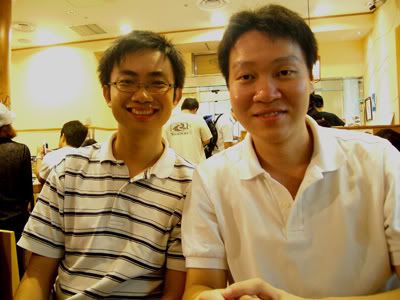23rd September (Tuesday)On this day is the Autumnal Equinox, a public holiday in Japan. We have decided the previous weekend to visit Meijimura (明治村 Meiji Village) which is a short distance away from where we are staying. From my place in Tokadai, it is only a 4km distance away. Nevertheless, via public transport, I have to take a bus to Komaki-Hara station first, transit by train to Inuyama station, follow by a bus ride to the Meijimura. There are buses almost every 20minutes from Inuyama station and it cost 410Yen.
We took the 9.23am train from Komaki-Hara station, followed by the 9.51am bus from Inuyama station and arrived at Meijimura at 10.10am.
Here is the entrance to the Meiji Village. There are two type of passes which we can get. The normal 1600Yen entrance or the combined 2200Yen ticket. The combined ticket allow you to take the rides in the village. We got the combined ticket.
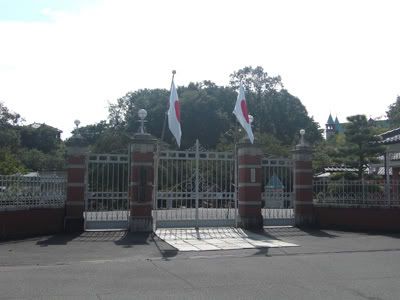
The sights in the village are all labelled on the map so we can follow a route and visit all the buildings in there. From the entrance, we arrived at the famous Meijimura sukiyaki (hot pot) shop which serves a meal for 2 for 5000-6000Yen. As it is not yet lunch time, we skip through the restaurant.
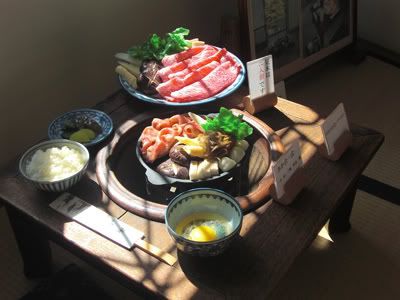
We visited at a meiji era primary school. From there we proceeded through a wooded path up the hill till we arrived at the St Paul Church. All the buildings in the village are relocated from all over Japan to here. So the materials used are exactly the same as back during the meiji era.
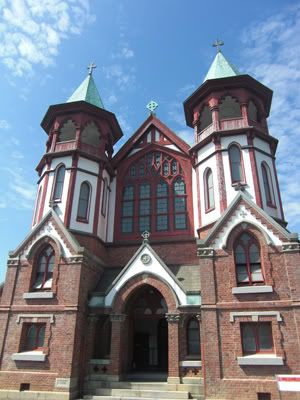
From there down is another important building. This building is earmarked to be a cultural asset in Japan.
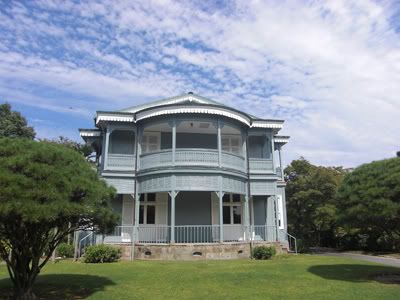
There is a house not far from there. It is said a famous Japanese writer stayed here. The house is rather spacious and quiet.
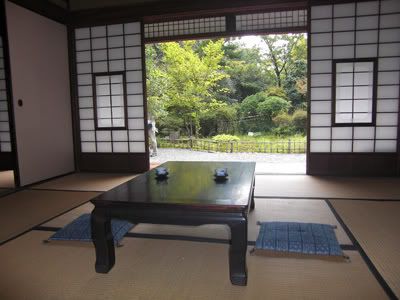
We took a group photo here by placing the camera on a cupboard.

This cat seems pretty famous. It is a cat made of stone.
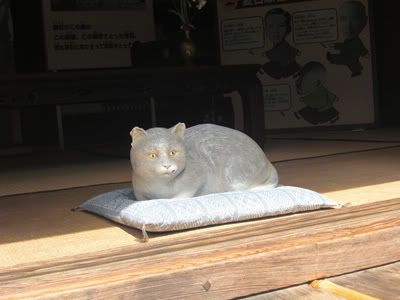
The last sight in the first area is Mie prefecture hall. It has many rooms showcasing the instruments used back then. There are the different type of clocks, watches, toys and so on.
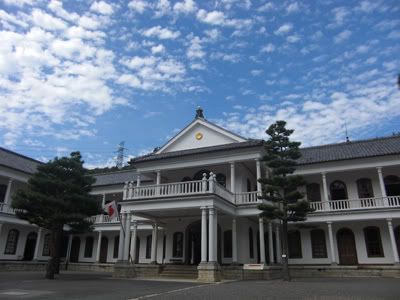
Here is the main office where the prefecture boss sits. Beside his table there is a shelf which has lots of papers. One is 'unprocessed documents', while the other is 'approved documents'. So basically that is all he does.
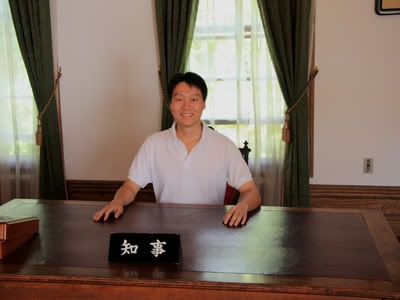
The main ball room. The girls are imagining the whole place coming alive at night. It has a spooky feel when they mention it.
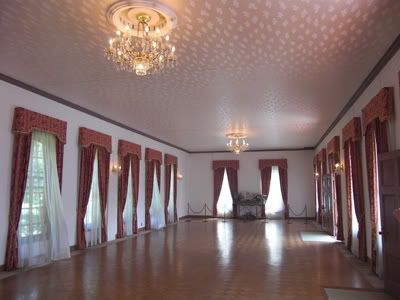
We arrived at the second area. This area has a distinctive Kyoto feel to it as many of its buildings came in from Kyoto.
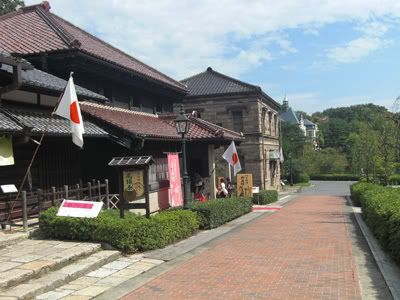
It is coming close to lunch time. Just nice in the second area, there is a food court. This food court is pretty famous for its Japanese curry.
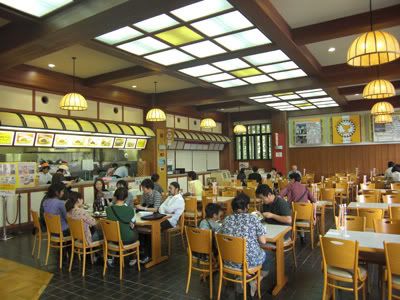
We ordered and shared a mega set with a medium-size set. It cost around 850Yen per person.
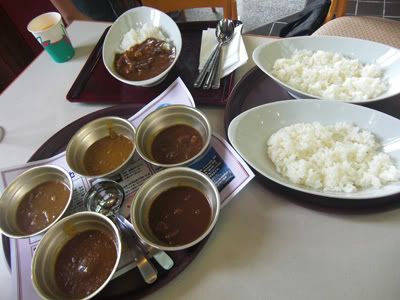
After lunch, we continue our exploration of the different buildings. Here is the view of the street from the second storey of the meiji village chief office.
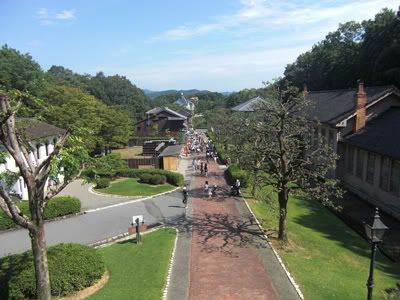
We visited one of the lecture rooms in those days and pretended to be students again.
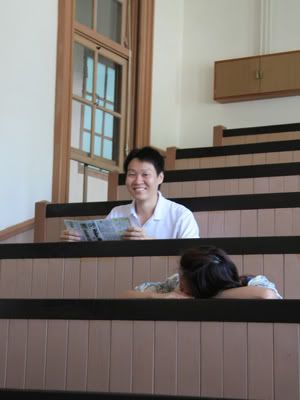
While visiting one of the houses, a tour is just about to start and we joined in. The house we will be visiting is actually a 4 storey high house with stairs leading high up to the roof top. We took a seat at the tatami mat and just listen to her describing the design of the house.
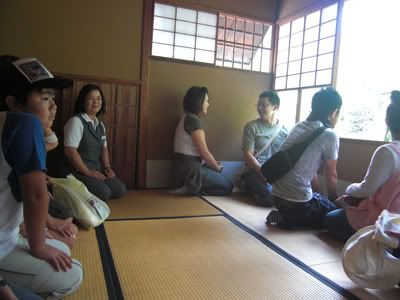
We walked down the street to the next area. It is here where we took a 20minutes break at a ice-cream palour. From there up the hill is a house which exhibits all the medical instruments used in those days and the prominent medical doctors.
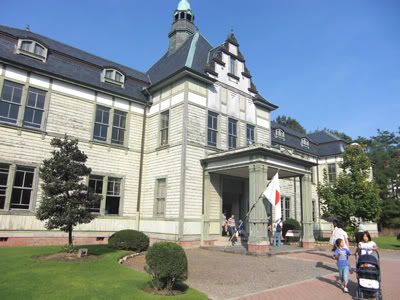
From the hilltop, we are granted a beautiful view of the surrounding parks and the lake.
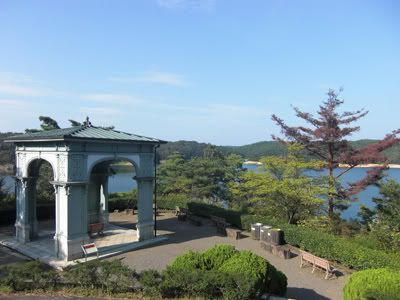
There is a mini-maze in the area which we are able to find out way out easily.
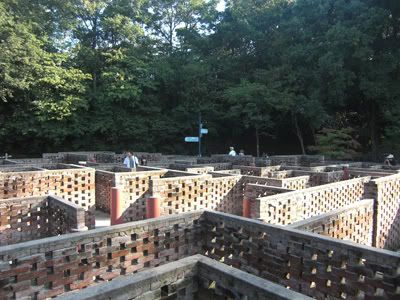
This is a lighthouse.
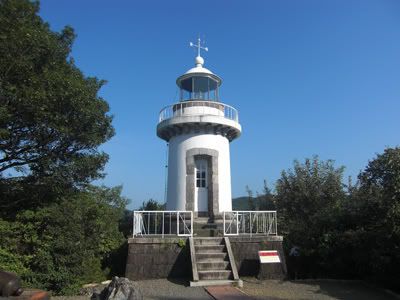
From Area 3, we decide to take a tram out to Area 4. Here comes the tram back in those days.
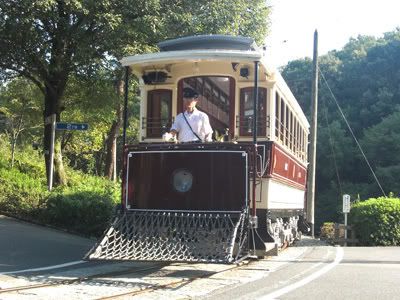
And I giving it a push.
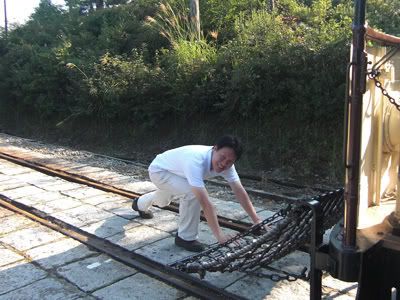
As we only have around an hour left before the park closes at 5pm. We decide to proceed straight to Area 5 by train. There are many more sights in Area 5 and the last train departs at 4.40pm.
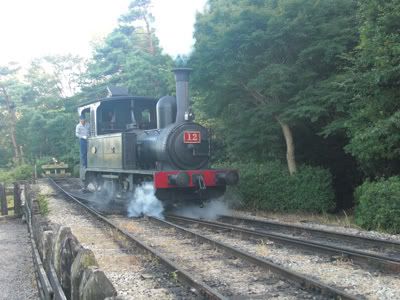
The Imperial Hotel. Many famous stars is said to have stayed in this hotel previously.
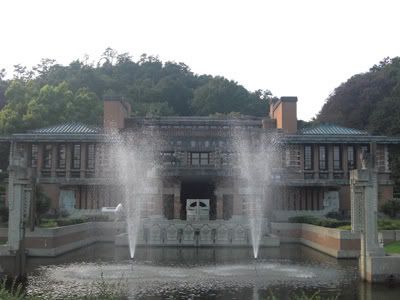
This half damaged building is also another famous landmark of the Meiji village. It is actually a part of a bank building in the past.
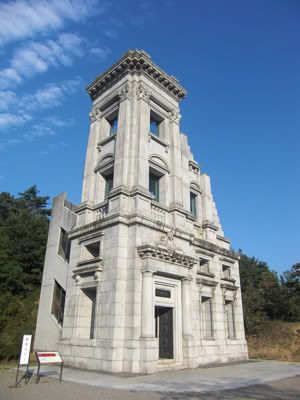
From the top we can catch the environs.

Another Meiji era building.

Another famous landmark in the fifth area is the prison area. Here are the gates leading into it.
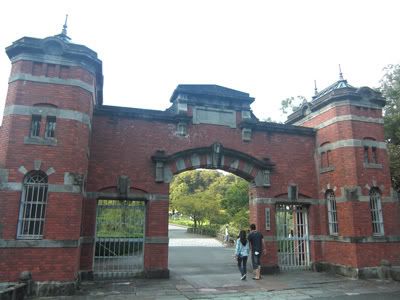
A typical prison cell. This prison seems quite luxurious. It is more spacious than some of the Japanese hotels.
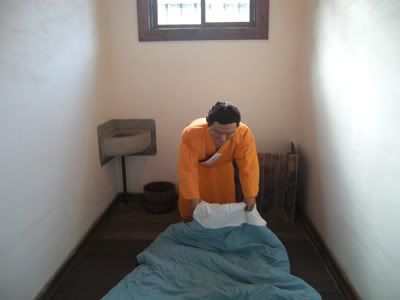
A Catholic church.

The sun is beginning to set, casting a glow against a cafe.
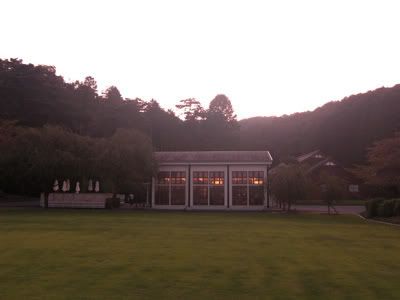
At the entrance/exit to the village, we too a group photo again.
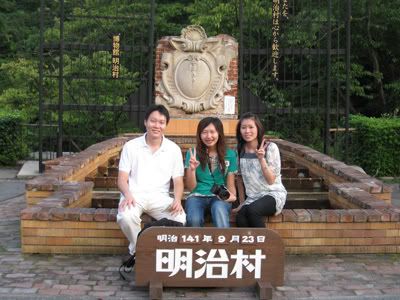
We left Meiji village at 5.10pm and got back to Inuyama station at 5.30pm. The plan was to have Korean dinner back in Komaki. Unfortunately it was closed, so we just drop by a izakaya for dinner.

We went for their set meal which cost 1470Yen each.
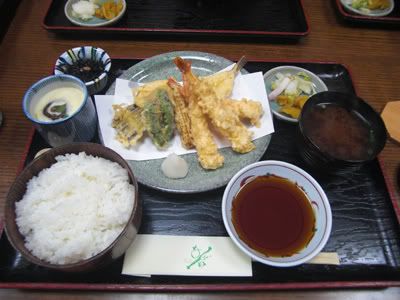
On the weekend of the 20th/21st September, I have the opportunity to meet up with David, an old friend from nusbs, and show him around town. It has really been sometime since I last met him, so I'm looking forward towards it.
By the middle of the week, I got a rough itinerary planned out. As David is a regular visitor to Japan, I find it best to show him the unique sights in Nagoya. The only challenge coming up is that the news kept reporting a typhoon is coming over to Japan. Thankfully it will zoom past by Nagoya on Friday night and by the weekend, it is all clear.
20th September (Saturday)
I rendezvous with David at his hotel at 10.30am in the morning. We bought a Nagoya subway day pass which cost 740Yen and visited the first sight for the day, the Toyota Commemorative Museum of Industry and Technology which is a subway stop away from Nagoya Station. We have a lot to catch up and talk about so much so that before we knew it, we have arrived at the museum. Here is the main hall of the museum. The entrance ticket cost 500Yen, but with our day pass there is a 100Yen discount. 
We were somewhat surprised that Toyota started as a textile manufacturer. The museum showcase all the different textile machinery that was used by Toyota in the early part of the century. One of the most pleasant surprise is that all the machineries are still running. There are guides at different part of the museum which demonstrate how these machineries work.
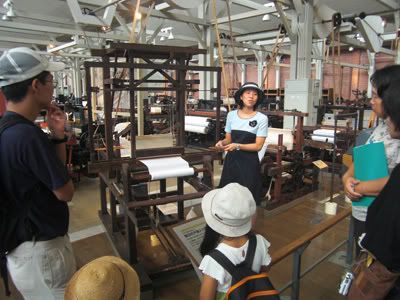
We briefly walked through the textile area, the metallurgy section and on to the main strength of Toyota, the Automobile area. "Always be studious and creative, striving to stay ahead of the times", this phrase is from the Five Main Principles of Toyota.

A large section of the automobile area is devoted to how the automobile industry came to be part of Toyota strength. In those days, the leading automobile companies are from the US and Europe. Japan did not really have the expertise to manufacture cars. Thus they went through a long process of learning the trade before finally able to mass produce automobiles.
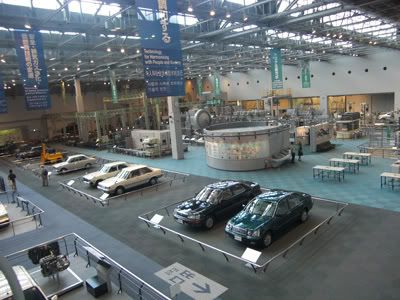
Here I am trying out one of the turning machanism found in cars.
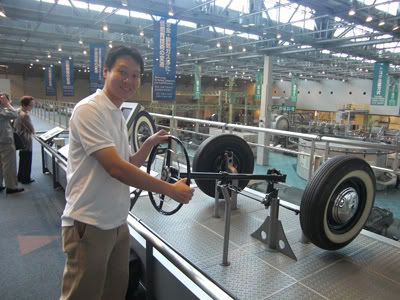
The part where we are the most impressed is how the automobiles are manufactured. We saw a few videos in there, as well as controlling the main manufacturing machinery. These are seriously real robots. It is agile, intelligent and robust. So captivated I am with these robotic technology that I recorded two videos of it below. My company also deal with such automation stuff.
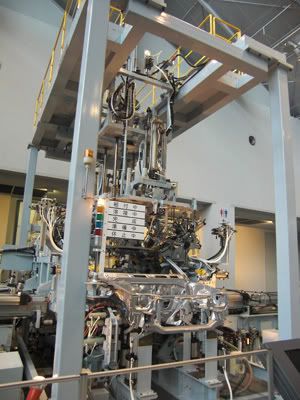
After the Toyota Museum, we took the subway to Jingu-West stop which is a 20minutes ride away. We continued our conversation and before we knew it, we are at the Atsuta Jingu. Here is where we are supposed to have our lunch. After searching quite a bit, we proceeded straight to the Jingu. It is here where we finally found the speciality of Nagoya and the restaurant recommended by the guide books - Kishimen. It cost 700Yen for this bowl of Kishimen.
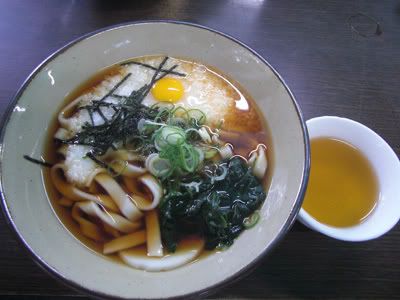
We walked further up and arrived at the Atsuta Jingu. After visiting the shrine, it started drizzling a bit and we got back to the subway stop.
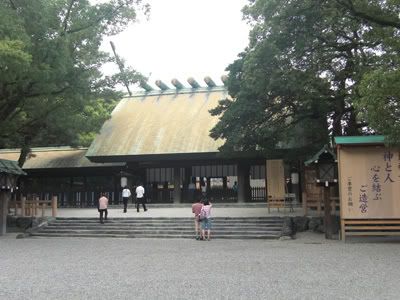
The next stop is visiting Osu Kannon, the large Buddhist temple in the city. Before going there, we walked through the shopping street of Osu.
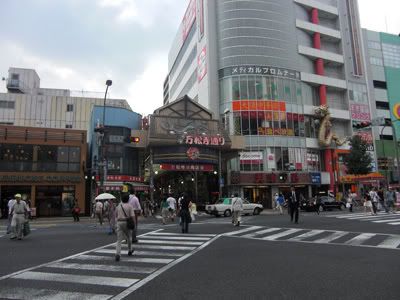
There are lots of pigeons in the Osu area.
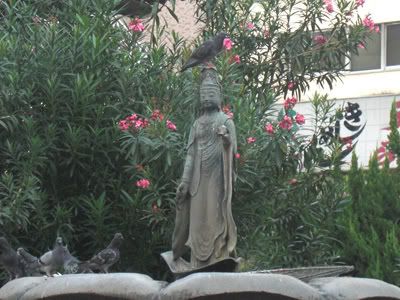
Here is our group photo.
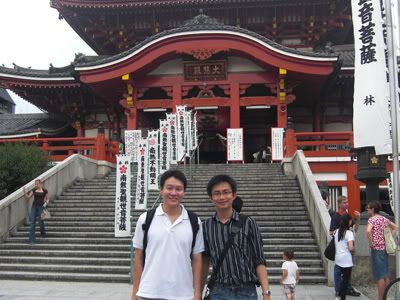
We walked to several sights within the Osu and Sakae area. The sun set at 6pm in Japan nowadays. By the time we reached Sakae, it is almost sundown. Shot this beautiful image of the Nagoya Tower with the Oasis 21 spaceship.
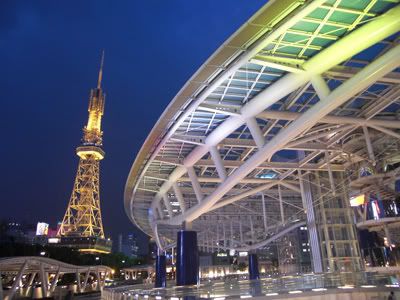
Thereafter we went for Yabadon at one of the shopping mall. The second speciality of Nagoya is the Miso Gatsu (Miso Pork Cutlet).
On the way for dinner, we came upon the Louis Vuitton shop. There are lots of CCTV pointing towards the LV bags.
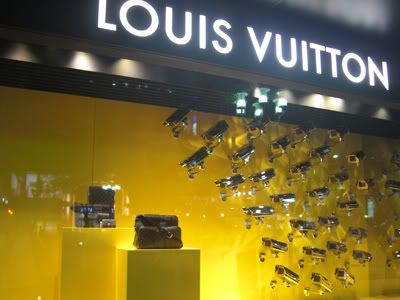
After dinner, we went back to Nagoya station and settle down at the cafe in Midland Square. We chatted for around 2 hours and found that it is time for us to call it a day. I took the 9.40pm bus back to Tokadai.
21st September (Sunday)
For this day, we rendezvous at 1.10pm at Inuyama train station. We made a brief stop at the Tourist Information Centre at the station. The staff recommended us to visit the Inuyama International Sightseeing Centre for our lunch. It is only a 5minutes walk away. The last order is at 1.30pm so we hurried there.
It is a pleasant restaurant which serve Western-style meals. We opted for the Pasta set meal.
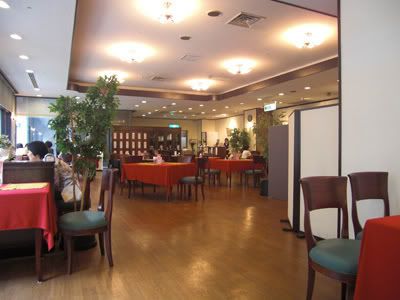
The pasta is laced with smoked salmon. It taste really good. The set meal only cost 860Yen.
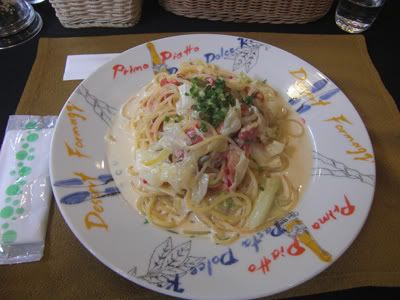
From there we decided to walk to Inuyama castle. It is only a 20minutes walk away. There are a few small temples along the way but time really past by quickly as we were also pretty engrossed in our conversations. And viola! We arrived at the shrines at the base of the castle.
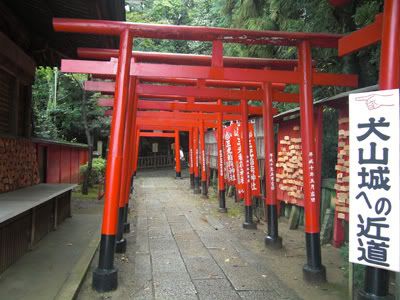
Here is Inuyama castle, the oldest castle in Japan. The entrance is 500Yen but we got a 100Yen discount by showing some brochure.
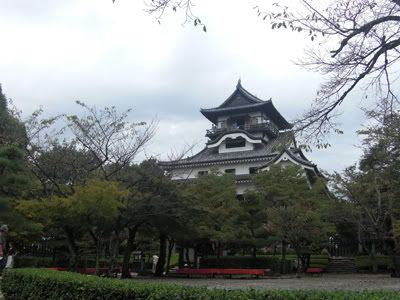
From the castle top, we have a splendid view of the Kiso river and the surrounding buildings.
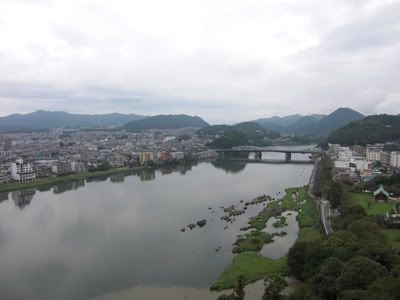
The ticket also entitled us to visit two museums around the castle. One of which showcase the 'floats' used in Inuyama festival.

The other museum is a doll museum. Here I am playing with a doll.
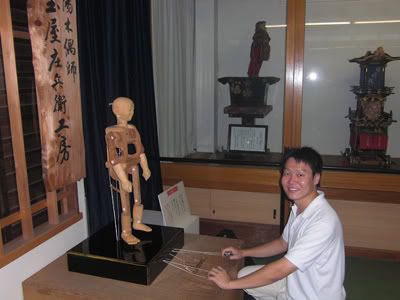
We left the museum around 4pm in the afternoon and it started raining. I am hoping for a cafe where we can just sit around and wait for the rain to stop. Fortunately when we went to Inuyama-Yuen station, there is a cafe just next to it. We spent the next 2 hours just sitting there and chatting.
When it approaches 6pm, we found the rain is getting to be heavier. We have to give the Ukai (cormorant fishing) a skip. From the station, there is a direct train to Nagoya. Though it is closer and cheaper for me to go back to Komaki from there, I decide to just go to Nagoya for dinner. I brought David to the ramen street in Nagoya station. Here we are having Nagoya ramen.
We bid each other farewell and I took the 7.40pm bus back to Tokadai.
